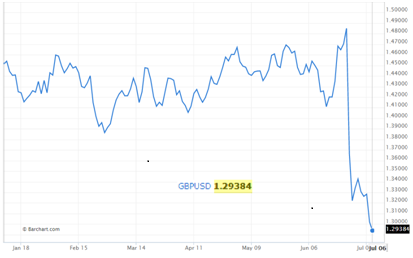It is the argument of this commentary that following the Brexit vote we may be entering into a period of regime uncertainty. By the latter we mean political, economic, and financial regimes. This could turn out to be a déjà vu watershed period for the global economy if we recall that it was the British again and their misconceived insistence to re-enter the gold standard at an unaffordable rate in 1925 that eventually led to the disasters of the 1930s. But let’s briefly review those facts.
The gold standard (where paper money is exchanged on demand with gold since it is backed by gold) worked fine until the beginning of World War I. When the war erupted, the gold standard was suspended, which allowed governments to print money and finance the war. The British tried to re-enter the gold standard at £4.25 per ounce (the pre-war parity). Of course such parity was fictional, unaffordable and unsustainable given the amount of money that the British had printed and circulated. Such inconceivable policy was deeply deflationary since money supply had to be withdrawn from the system (actually money supply had to be cut by 50%) with the result being lower business activity, freezing of credit and investments, and a stagnant economy destined to experience a deep recession.
The US Fed in order to support such foolish policy had to accommodate it by following a policy of cheapening the USD in order to strengthen the sterling pound and the British effort to re-enter the gold standard at overvalued currency levels. Such support by the US Fed meant that the US monetary policy had to be expansionary with the result being over-extension of credit, the “roaring twenties”, the bubbles, the stock market crash in 1929, and the Great Depression that followed.
Of course an over-valued sterling pound gave France a big competitive advantage which finally forced Britain to abandon the gold standard in 1931 and in turn left the US with no alternative but to devalue the dollar in 1933 and the vicious cycle of deflation, depression, and devaluation to start feeding a frenzy of uncertainty that destroys capital, jobs, and growth prospects.
The recent drop of the sterling pound (see graph below) signify the fact that fiat money (money printed by central authority decree but which has no intrinsic, subjective, historical, speculative, or trajectory value) outside a framework of an anchor is simply a train wreck waiting to happen. The problem is that this train now carries weapons of mass deception (derivative liabilities traded among large banks that worth hundreds of trillions of dollars).
Given the limitations of monetary policy, the political turmoil in the UK, the EU (most probably the Italian Prime Minister will be forced to resign after he loses the October referendum, and with elections due in France and Germany next year), and the impending US elections, the fears about financial stability may emerge again, and thus absent a dramatic policy turn- around which will allow confidence to be rebuilt, capital commitments will become thinner and thinner. As capital stays in the sidelines, growth prospects will decline, earnings expectations will be downgraded, and an environment of regime and value uncertainty may prevail.
What do all these developments mean for investors? We could simply state that acquiring real money in the form of hard assets/precious metals as well as options on those might not be such a bad idea.

